If you’;Sei nuovo al ricamo, imparare i termini del ricamo a macchina è essenziale per il successo. Questi termini chiave ti aiuteranno a utilizzare correttamente la tua macchina e i tuoi materiali.
In questa guida, analizzeremo i termini più importanti in un linguaggio semplice, rendendo più facile per te creare bellissimi disegni con sicurezza.
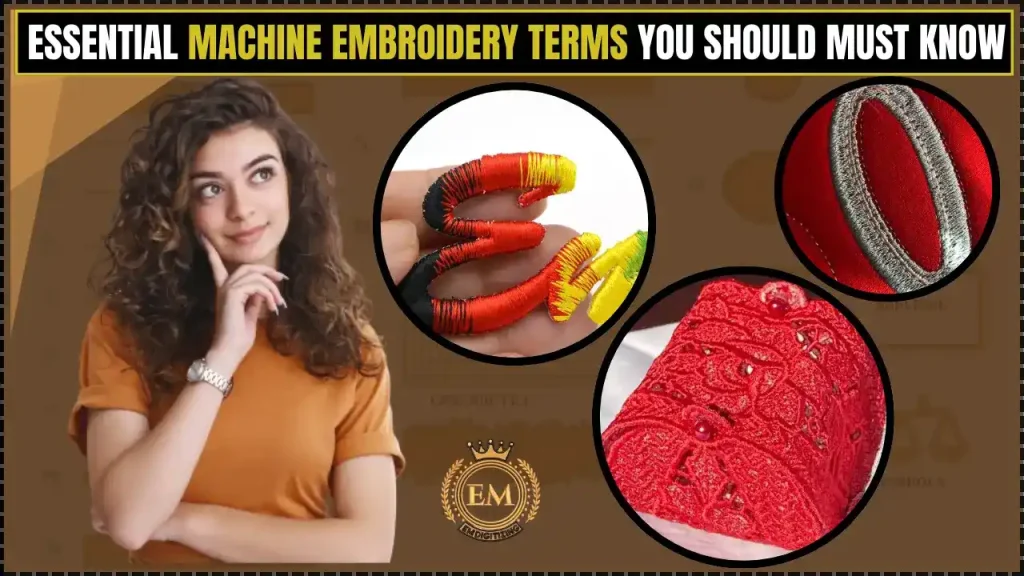
Termini essenziali del ricamo a macchina che dovresti conoscere
Comprendere la macchina da ricamo
Per usare il tuo macchina da ricamo correttamente, è importante conoscere le parti principali e come funzionano insieme. Ciò renderà i tuoi progetti di ricamo molto più semplici e di maggior successo.
Componenti chiave di una macchina da ricamo
La tua macchina da ricamo è dotata di diverse parti essenziali che le consentono di creare disegni su tessuto. Comprendere questi termini di ricamo a macchina ti aiuterà a utilizzare la macchina in modo efficiente e a ottenere risultati migliori.
Ecco alcuni dei componenti più importanti:
Telaio da ricamo: Un telaio che tiene teso il tessuto durante la cucitura, garantendo un ricamo liscio e uniforme.
Ago: Lo strumento affilato che si muove su e giù per creare punti attraverso il tessuto.

Bobina: Una piccola bobina che fornisce il filo inferiore, lavorare con il filo superiore per formare delle maglie.
Stabilizzatore: Un materiale posizionato sotto il tessuto per evitare stiramenti o arricciature durante il ricamo.
Quadrante di tensione del filo: Controlla la tensione del filo per garantire cuciture uniformi e lisce.

Piedino premistoffa: Tiene fermo il tessuto mentre si muove attraverso la macchina, consentendo cuciture precise.
Dai da mangiare ai cani: Denti in metallo che muovono il tessuto in avanti durante la cucitura.
Piastra per la gola: Una piastra metallica con un'apertura per il passaggio dell'ago durante la cucitura.
Barra dell'ago: Tiene l'ago e lo muove su e giù durante il processo di ricamo.
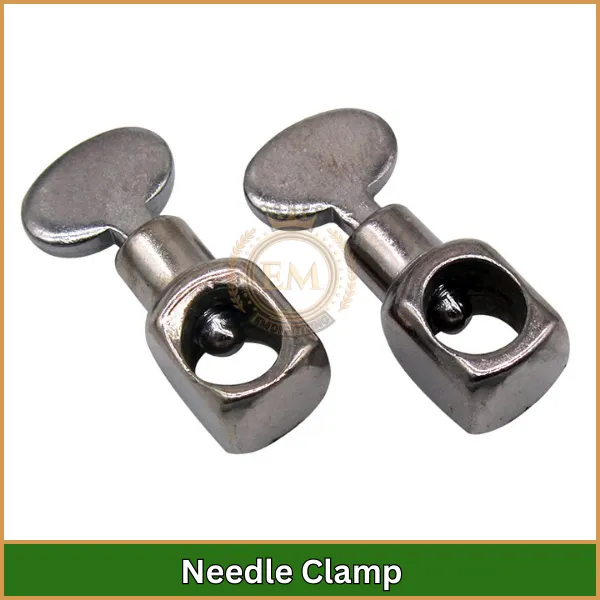
Morsetto dell'ago: Fissa l'ago in posizione, garantendo stabilità durante la cucitura.
Perno della bobina: Tiene il rocchetto di filo, permettendogli di svolgersi agevolmente mentre la macchina cuce.
Pannello di controllo: L'interfaccia in cui regoli le impostazioni e selezioni i disegni per la cucitura.

Supporto per telaio da ricamo (Braccio): Sposta il telaio per seguire le coordinate del disegno per un posizionamento accurato del disegno.
Tagliafilo automatico: Taglia automaticamente il filo dopo la cucitura o i cambi di colore.
Taglierina per punti saltati: Taglia il filo in eccesso tra le sezioni del disegno per mantenere pulito il retro.
Meccanismo di cambio colore: Passa automaticamente da uno all'altro colori del filo su macchine multiago.
Come funziona una macchina da ricamo
Le macchine da ricamo utilizzano un sistema computerizzato per cucire i disegni sul tessuto. Si carica un file di disegno nella macchina, posizionare il tessuto nel telaio, and the machine follows the design’;s istruzioni per creare il modello con il filo.
Termini essenziali dei materiali per ricamo a macchina
Comprendere il diritto strumenti per ricamo e i materiali sono fondamentali per ottenere termini di ricamo a macchina di successo. Questi strumenti e materiali aiutano a garantire che i tuoi progetti risultino perfetti, accurato, e dall'aspetto professionale.
- Tessuto: Il materiale di base su cui è cucito il disegno da ricamo. Tessuti diversi, come il cotone, biancheria, o poliestere, reagiscono diversamente al ricamo, quindi selezionare il tessuto giusto è fondamentale per ottenere i migliori risultati.
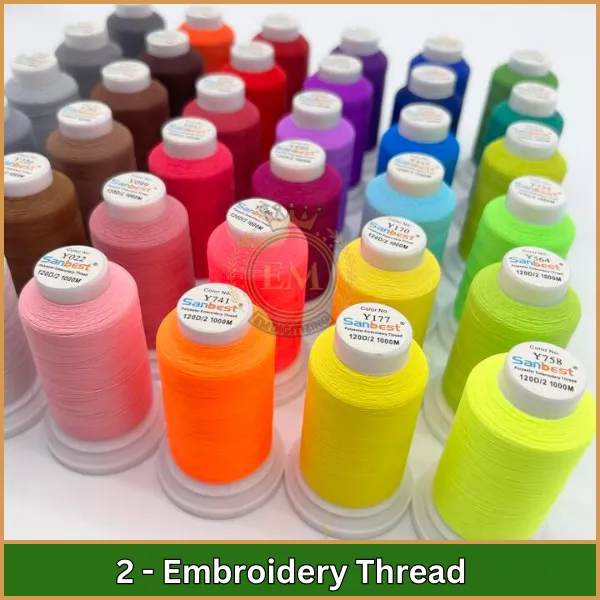
2. Filo da ricamo: Un tipo speciale di filo utilizzato in ricamo a macchina termini.
Di solito è fatto di rayon, poliestere, o cotone ed è disponibile in una varietà di colori per aggiungere vivacità ai tuoi disegni.
I fili da ricamo sono progettati per essere resistenti e fornire una trama liscia, finitura lucida.
- Stabilizzatore: Materiale di supporto posizionato sotto o dietro il tessuto per fornire ulteriore supporto durante il ricamo. Gli stabilizzatori impediscono l'allungamento del tessuto, spostamento, o increspature, assicurando che il disegno si cucisca senza intoppi. I tipi comuni includono lo strappo, spaccato, e stabilizzatori lavabili.
- Cerchio: Un telaio che mantiene il tessuto saldamente in posizione durante il processo di ricamo. Il cerchio è composto da due anelli: Un anello interno e un anello esterno, che bloccano il tessuto per mantenerlo fermo, garantendo cuciture precise.
- Ago: Uno strumento affilato utilizzato per cucire il disegno nel tessuto. Gli aghi da ricamo sono progettati per gestire fili e tessuti delicati senza causare danni. Sono disponibili diverse dimensioni e tipi di aghi a seconda del tessuto e della complessità del disegno.
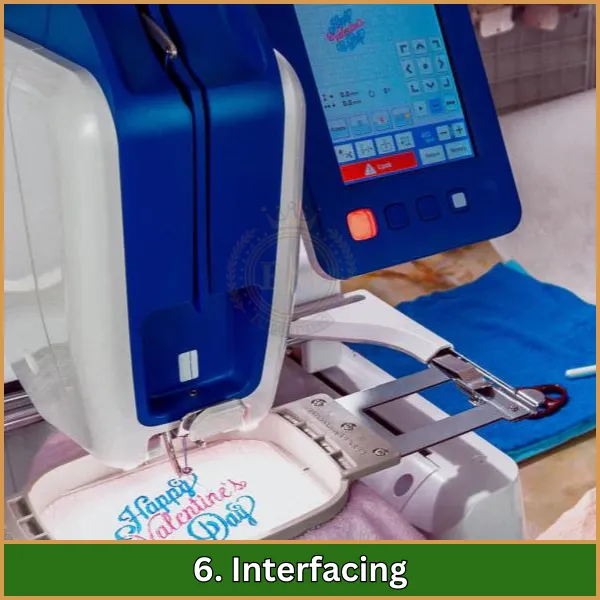
6. Interfacciamento: Un materiale utilizzato per rinforzare tessuti che potrebbero essere troppo sottili o delicati per il ricamo.
Aiuta a stabilizzare il tessuto e a prevenire la distorsione durante la cucitura.
L'interfaccia viene spesso fusa al tessuto utilizzando il calore prima dell'inizio del ricamo.
- Stabilizzatore solubile in acqua: Un tipo speciale di stabilizzante che si dissolve se immerso in acqua. Viene spesso utilizzato per pizzi indipendenti o tessuti delicati in cui lo stabilizzatore dovrebbe scomparire una volta completato il ricamo.
- Spray adesivo temporaneo: Uno spray utilizzato per trattenere temporaneamente il tessuto, stabilizzatore, o applicare l'applicazione in posizione prima della cucitura. Aiuta a prevenire il movimento del tessuto durante il processo di ricamo ed è particolarmente utile per i tessuti difficili.
- Tessuto applicato: Un pezzo di tessuto posizionato sopra il tessuto di base e cucito utilizzando punti di ricamo. L'appliqué è una tecnica in cui le forme vengono ritagliate e cucite su un pezzo più grande per creare disegni, spesso aggiungendo consistenza e colore progetti di ricamo.
Nozioni di base sulla digitalizzazione per il ricamo
Nel mondo di termini di ricamo a macchina, la digitalizzazione è un processo essenziale in cui i disegni vengono convertiti in un formato leggibile dalle macchine da ricamo. Ecco i termini chiave utilizzati nella digitalizzazione, insieme alle loro definizioni.
Software di digitalizzazione
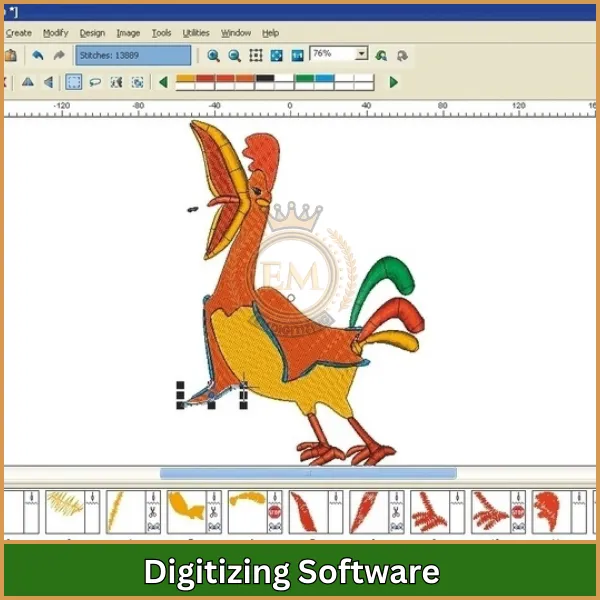
Questo è il software del computer utilizzato per creare o convertire un disegno in un file file di ricamo. Consente all'utente di mappare i percorsi dei punti, selezionare i tipi di punto, e regolare le impostazioni per creare il disegno finale che seguirà la macchina da ricamo.
Digitalizzazione automatica
Una caratteristica in software di digitalizzazione che converte automaticamente un'immagine o un elemento grafico in un disegno punto. Anche se questa è un'opzione più veloce, potrebbe non sempre produrre un design della massima qualità poiché potrebbero essere necessarie regolazioni manuali per dettagli complessi.
Digitalizzazione manuale
Questo è il processo in cui l'utente crea manualmente il file disegno del ricamo punto per punto. Offre il controllo completo sul design, consentendo una migliore precisione, soprattutto con modelli complessi o dettagliati.
Formati di file di ricamo
Questi sono i tipi di file specifici che una macchina da ricamo legge per realizzare un disegno. Macchine diverse utilizzano formati diversi. I formati comuni includono:
- Ora legale (utilizzato da molti marchi, comprese le macchine industriali),
- PES (utilizzato da Brother e Babylock),
- JEF (utilizzato da Janome),
- SCAD (utilizzato da Melco e Bernina).
Punti sottostanti
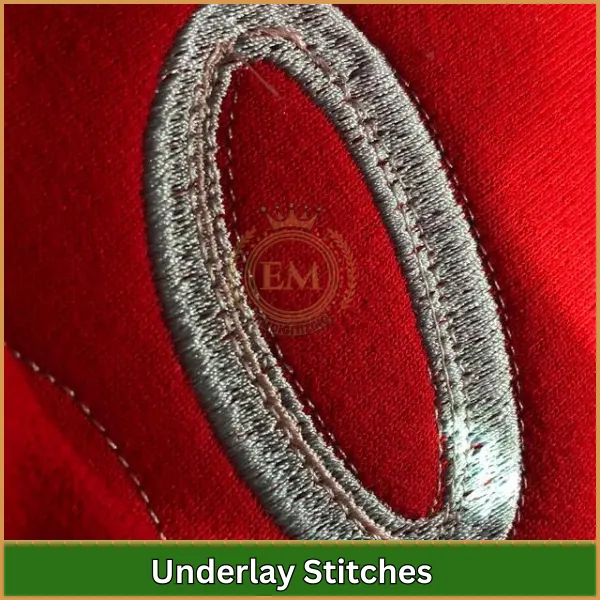
Questi sono i primi punti stabiliti in un disegno per stabilizzare il tessuto e prepararlo per la cucitura principale.
I punti sottopunto sono solitamente nascosti nel prodotto finale, ma sono fondamentali per fornire struttura e garantire che il disegno mantenga la sua forma.
Compensazione push e pull
Un'impostazione nel software di digitalizzazione che compensa il movimento o la distorsione del tessuto durante il processo di ricamo. Garantisce che i punti rimangano allineati con il disegno originale nonostante lo spostamento o la trazione del tessuto durante la cucitura.
Percorso
Il percorso si riferisce alla sequenza in cui i punti vengono disposti durante il ricamo. Il percorso corretto riduce al minimo i salti o i tagli del filo non necessari, facendo funzionare la macchina in modo più efficiente e producendo risultati più puliti.
Densità
La densità si riferisce a quanto vicini sono posizionati i punti all'interno di un disegno. La regolazione della densità può influire sull'aspetto, struttura, e rigidità del design. Troppa densità può rendere il tessuto rigido, mentre troppo poco può provocare spazi vuoti o cuciture allentate.
Tipi di punti: Dal semplice al complesso

Diversi tipi di punti creano effetti diversi nei tuoi ricami. Ecco alcuni dei punti più comuni:
- Punto corrente: Si tratta di un punto semplice che forma una linea retta e viene spesso utilizzato per delineare disegni o aggiungere piccoli dettagli.
- Punto raso: I punti satin creano punti lisci, aree lucide del filo e sono ottime per i bordi, lettere, o riempire piccole aree.
- Punto di riempimento (Punto Tatami): Un punto di riempimento viene utilizzato per coprire ampie aree di un disegno con punti fitti. Aggiunge consistenza e riempie le forme con il colore.
- Punto a zigzag: Un punto che si muove avanti e indietro seguendo uno schema a zigzag. Questo punto viene spesso utilizzato per bordi decorativi o per rifinire i bordi del tessuto.
- Punto croce: A stitch that forms an ‘;X’; forma sul tessuto. Viene spesso utilizzato nel ricamo a mano, ma può essere adattato ai termini del ricamo a macchina per creare disegni complessi.
Padroneggiare i termini del ricamo a macchina: Tecniche Avanzate
Imparare tecniche avanzate può aiutarti a portare i tuoi progetti di ricamo al livello successivo. Ecco alcune tecniche chiave da padroneggiare:
Punti di stratificazione
La sovrapposizione dei punti implica l'impilamento di diversi tipi di punti uno sopra l'altro per creare profondità e consistenza nel tuo disegno. Questa tecnica aggiunge un aspetto più professionale e dimensionale al tuo ricamo.
Filo sfumato
Questa tecnica utilizza un filo che cambia gradualmente colore, creando un effetto di dissolvenza o fusione nel disegno. È perfetto per aggiungere un tocco dinamico e artistico ai tuoi ricami.
3D Ricamo

3Il ricamo D utilizza schiuma o altri materiali posizionati sotto i punti per far risaltare il disegno dal tessuto, creando un effetto tridimensionale in rilievo. È comunemente usato per loghi in grassetto o oggetti decorativi.
Nel cerchio (ITH) Progetti
I progetti ITH sono realizzati interamente all'interno del telaio da ricamo, il che significa che puoi creare oggetti completi come borse, giocattoli, o sottobicchieri senza rimuovere il tessuto dal telaio. Questa tecnica combina cucito e ricamo in una volta sola.
Applicazione
L'appliqué è una tecnica in cui pezzi di tessuto vengono posizionati sopra il tessuto di base e poi cuciti utilizzando il ricamo. Permette diverse texture e colori, rendendo i disegni più vivaci e interessanti.
Pizzo autoportante (FSL)
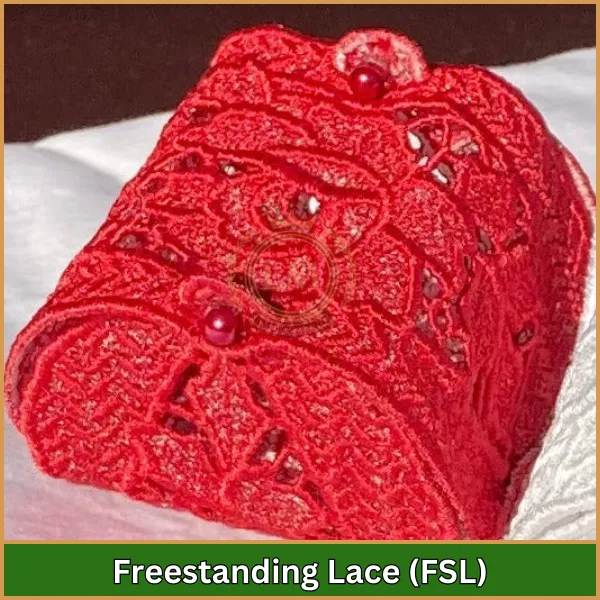
Il pizzo indipendente implica la creazione di intricati disegni di pizzo che possono stare da soli senza una base in tessuto.
Questo viene fatto cucendo sullo stabilizzatore solubile in acqua, che si dissolve una volta completato il ricamo, lasciando dietro di sé solo il pizzo.
Conclusione
Imparare questi termini relativi al ricamo a macchina renderà l'utilizzo della tua macchina da ricamo più semplice e divertente. Conoscere questi termini ti aiuterà a evitare errori e a creare bellissimi design in modo rapido e semplice.
In EMDigitalizzazione, possiamo aiutarti a trasformare le tue idee in disegni da ricamo. Offriamo un servizio veloce, prezzi bassi, e un lavoro di alta qualità per garantire che i tuoi progetti risultino perfetti.
Più, se è la prima volta che lavori con noi, otterrai 50% dal tuo primo ordine! Lascia che ti aiutiamo con la parte difficile, così potrai divertirti a realizzare i tuoi progetti di ricamo.
Domande frequenti
Esistono principalmente due tipi di ricamo a macchina: ricamo a mano libera e ricamo computerizzato. La mano libera si basa sul controllo manuale, mentre il ricamo computerizzato utilizza disegni preprogrammati per cuciture precise.
I sei punti di ricamo essenziali includono il punto continuo, punto indietro, punto pieno, punto gambo, Nodo francese, e pigra margherita. Questi punti costituiscono la base per la creazione di varie trame e motivi nel ricamo.
Le migliori macchine da ricamo in Italia 2024 includere:
- Fratello SE600
- Fratello SE1900
- Bernette b79
- Mestiere di memoria Janome 14000
- Mestiere di memoria Janome 9850
Il nodo a lingotto è considerato uno dei punti di ricamo più difficili. Il suo intricato aspetto a spirale richiede precisione, poiché è necessario avvolgere il filo attorno all'ago più volte prima di farlo passare attraverso il tessuto.
